Dice Games: Easy and Fun Games for Kids
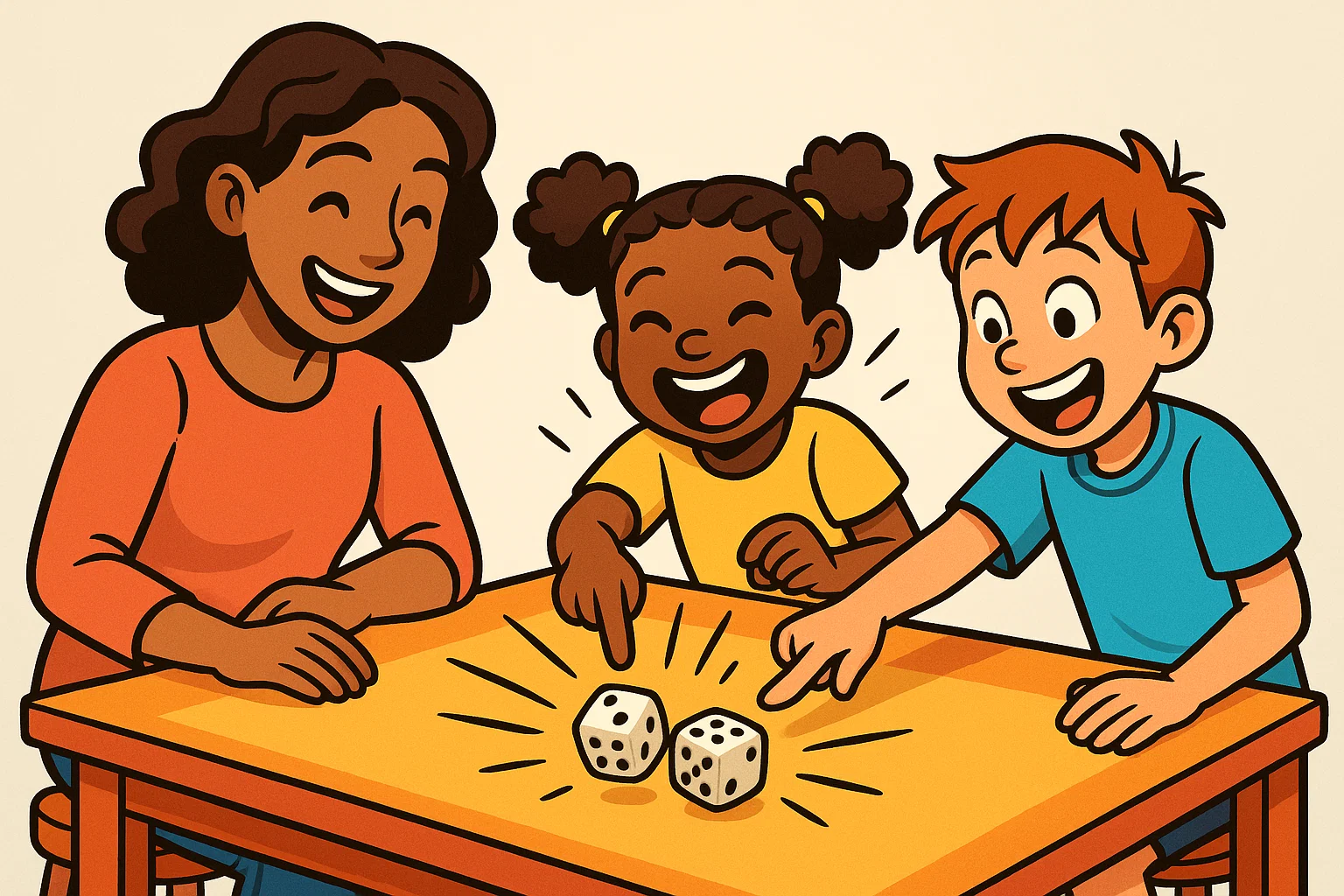
Rolling dice offer children an engaging way to learn, play, and develop essential skills without complex equipment or lengthy setup times. Whether you’re looking for games to play during family game night or seeking activities that combine fun with learning, these versatile entertainments provide options for various age groups and skill levels.
Benefits of Fun Dice Games
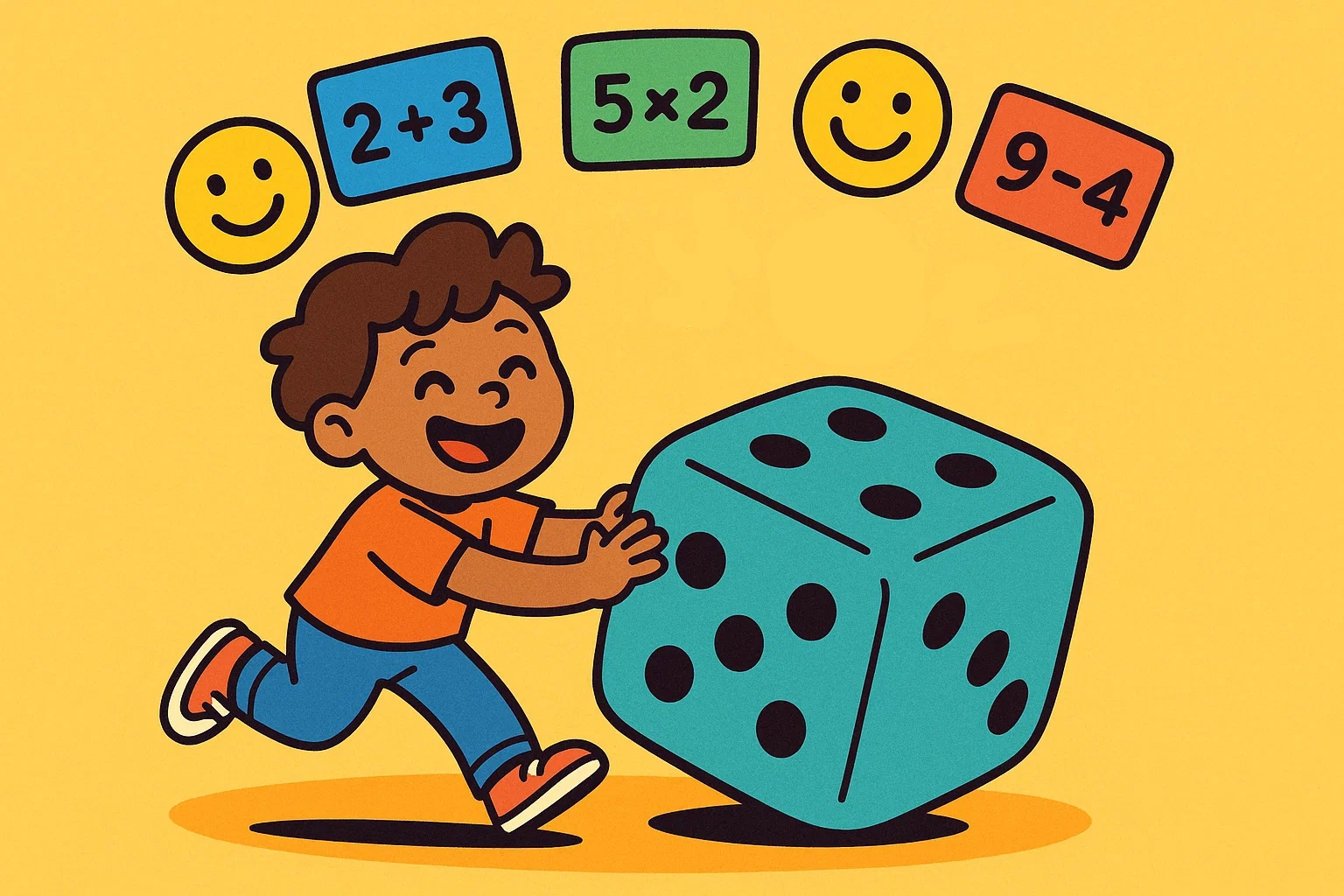
Beyond simple entertainment, rolling cubes offer tangible benefits. Understanding these advantages highlights why dice activities are essential for development.
Cognitive Skill Development
When children engage with these games, they’re doing more than simply having fun—they’re building foundational cognitive abilities. These activities help children develop visual perception as they quickly recognize different numbers shown on rolled cubes.
Turn taking inherent in these games teaches patience and impulse control.
Learning Math Fundamentals
Fun dice games for math create natural opportunities to practice basic mathematical concepts without the pressure of formal instruction. When a player rolls two dice and must calculate the total, they’re practicing addition in a meaningful context. Games involving dice and adding reinforce number sense and computational fluency.
Children develop math skills organically as they compare numbers, count dots, and track scores throughout gameplay.
More advanced games introduce multiplication, subtraction, and even basic probability. A child calculating whether to roll remaining dice or hold their current score begins understanding risk assessment—a sophisticated mathematical concept presented through play.
Family Leisure and Shared Time
These games create connection points between family members of different ages and abilities. Unlike screen-based entertainment, they require face-to-face interaction that strengthens relationships and builds social skills.
The shared experience of rolling and celebrating wins (or commiserating over losses) creates lasting memories. Parents report that regular game sessions provide consistent opportunities for conversation, laughter, and teaching moments about sportsmanship and fairness.
Easy Dice Games for Kids
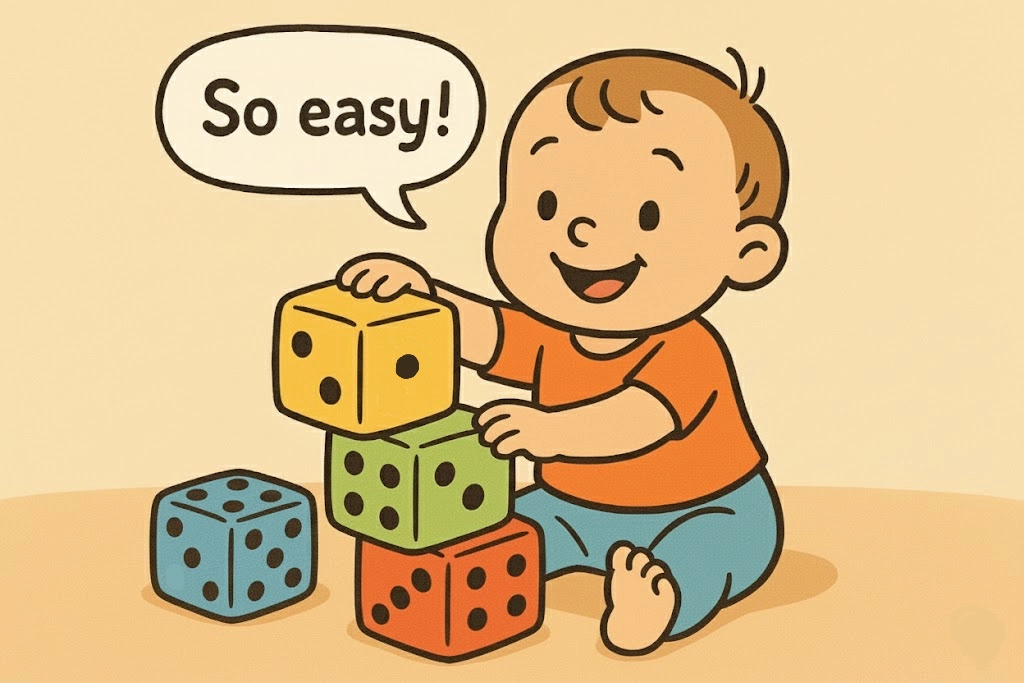
The best part? You don’t need complex instructions or long setups to start. Let’s look at several easy dice games for kids perfect for quick, spontaneous fun.
Simple Games for Young Children
Beat That! remains one of the most accessible introductions to rolling games. Each player rolls two dice and arranges them to create the highest possible two-digit number. A child who rolls a 4 and a 6 should position them as 64 rather than 46. The first player to win five rounds becomes the overall winner.
This game requires only basic number recognition and helps children understand place value. The simple premise means you can teach the rules in under a minute, making it ideal for short attention spans.
Race energizes young players through movement and counting. Players roll a single die and move that many spaces on a homemade game board. The first player to reach the finish line wins. You can customize the board with themes that interest your child—dinosaurs, space exploration, or fairy tales—to increase engagement.
Games with a Low Barrier to Entry
Tenzi has gained popularity for good reason. This game requires ten dice per player, and the objective is straightforward: roll all your pieces, choose a number you want to focus on, then continue rolling the remaining dice until all ten show your chosen number. The speed element adds excitement as players race against each other.
The game’s simplicity belies its benefits. Children develop hand-eye coordination, practice rapid counting, and learn to maintain focus amid the chaos of simultaneous play. Variations like “Splitzi” (getting five of one number and five of another) or “Oddzi” (only odd numbers) add complexity as skills improve.
Pig requires just one or two dice and teaches strategic thinking. On their turn, a player rolls the die repeatedly, accumulating points with each roll. However, if they roll a 1, they lose all points for that turn. Players must decide whether to “bank” their current points or risk another roll for more.
This introduces probability concepts naturally. Children begin recognizing that the chance of rolling a 1 increases with each successive roll, helping them understand when pushing their luck becomes unwise.
Competitive Games to Play
Going to Boston brings competitive excitement while remaining accessible to elementary-aged children. Each player gets three dice and three rolls per round. On the first roll, they keep the highest die. On the second roll of the remaining two dice, they again keep the highest. Finally, they roll the last die once. Players sum their three cubes, and whoever has the highest total wins the round.
The game balances luck with strategy—players can’t control what they roll, but they must decide which die to keep when two show the same number. Games typically consist of five to ten rounds, with the player winning the most rounds declared overall champion.
Knock Out adds elimination excitement. Players roll two dice and multiply the results. If their product matches another player’s score, that player is “knocked out” of the round. The last player remaining earns points. This game requires multiplication fluency and works well for children practicing their times tables.
Popular Dice Game Names
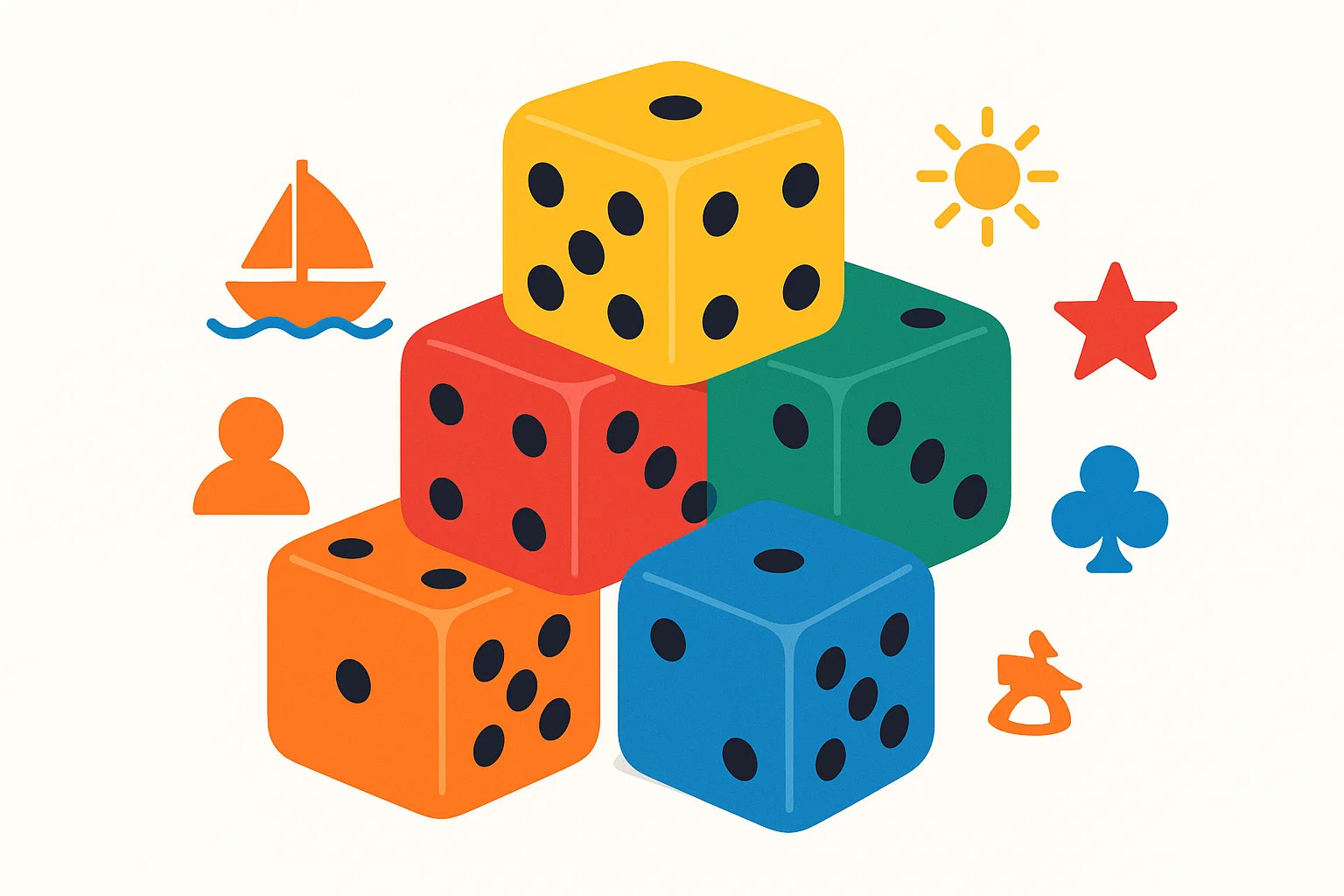
We’ve covered some simple, unnamed concepts. Next, we turn to the classic, named titles that have remained popular for generations, offering balanced challenge and fun.
The Game of Boston (or Going to Boston)
This classic carries multiple names but maintains consistent appeal across generations. As mentioned earlier, the game requires three dice and rewards both luck and tactical thinking. Some families call it “Newmarket” or “Yankee Grab,” but gameplay remains essentially identical.
Historical records suggest variations of this existed in colonial America, making it one of the oldest continuously played rolling games in Western culture. Its longevity speaks to its balanced design—simple enough for children, yet engaging enough that adults don’t feel bored playing along.
Strategy emerges when player rolls two dice showing the same high number during their first roll. Do they keep one and risk the remaining die showing lower? Or select the absolute highest and hope for better luck on subsequent rolls? These decisions create narrative tension that keeps everyone engaged.
Bunco
Bunco brings social energy to gaming through its party atmosphere and team-based structure. This typically involves twelve players divided into four teams of three, though you can adapt numbers as needed. Players roll three dice attempting to match the target number for that round.
The game progresses through six rounds, with each round targeting numbers 1 through 6 respectively. Rolling three-of-a-kind of the target number (a “Bunco”) scores maximum points and triggers celebration. Rolling any other three-of-a-kind scores five points, while matching individual dice score one point each.
According to the World Bunco Association, over 20 million people play regularly, making it one of the most popular social rolling games globally. The structure encourages conversation and laughter between rolls, creating a community-building experience beyond the competition itself.
Farkle
Farkle (also called Farkel, Zonk, or Zilch) offers deeper strategic complexity suitable for older children and adults. Players roll 6 dice and must set aside scoring pieces after each roll. They can continue rolling remaining dice to accumulate more points or stop and bank their current score.
The scoring system rewards certain combinations:
| Roll Type | Point Value |
| Each 1 rolled | 100 points |
| Each 5 rolled | 50 points |
| Three 1s | 1,000 points |
| Three of any other number | 100 × that number |
| Four of a kind | Double the three-of-a-kind value |
| Straight (1-2-3-4-5-6) | 1,500 points |
| Three pairs | 1,000 points |
The risk element comes from “Farkling”—if you roll and get no scoring pieces, you lose all points accumulated during that turn. This teaches children about calculated risk and knowing when to accept smaller guaranteed rewards versus gambling for larger uncertain ones.
Zanzibar
Zanzibar brings gambling excitement (without real stakes) to family game night. Each player starts with three tokens or chips. Players roll three dice, and the goal is to avoid rolling certain combinations that cost you tokens.
Rolling three-of-a-kind forces you to put a token in the pot. Rolling a “Zanzibar” (4-5-6) means you’re safe and can continue to the next round. Rolling an “Aces” (1-2-3) requires you to contribute two tokens. The strategic element involves deciding when to pass quickly and when to take your chances.
The game continues until one player loses all their tokens. This helps children understand probability while providing quick-paced entertainment. Sessions rarely exceed 15 minutes, making it perfect for time-limited situations.
Strategy and Fun Dice Games
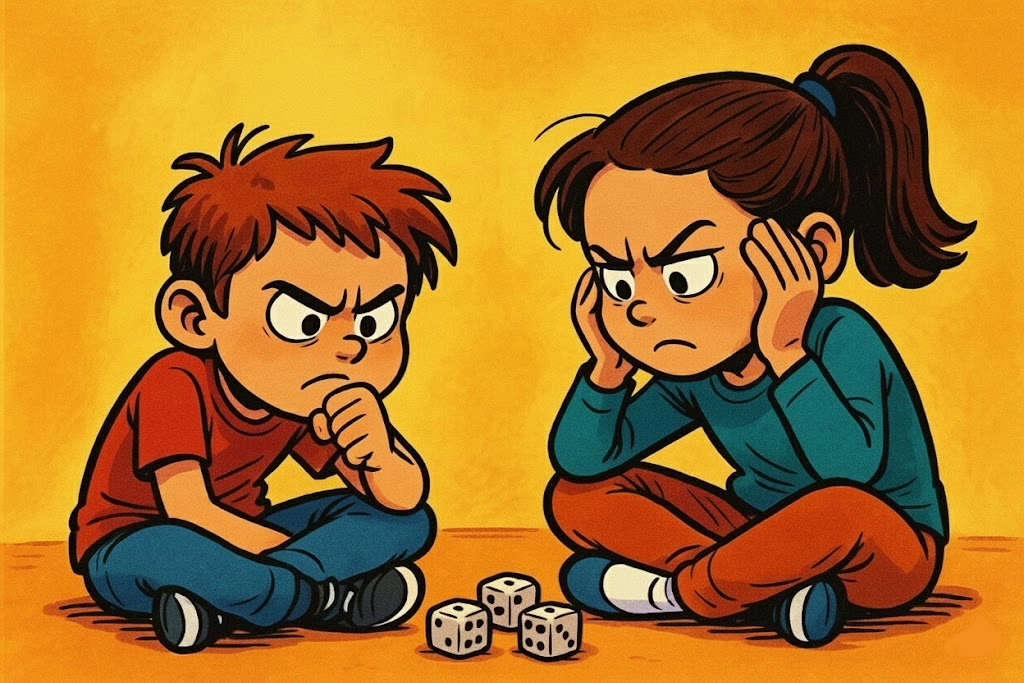
Once basic skills are mastered, kids often seek deeper engagement. These games move beyond pure luck and require calculated risks and strategic planning.
Creative Dice Challenges
Story dice transforms rolling into narrative generators. These specialty pieces feature pictures instead of dots. Players roll six dice and must create a story incorporating all the images shown. This develops creativity, verbal skills, and logical sequencing as children construct coherent narratives from random elements.
You can create your own version using regular dice by assigning each number a story element:
- A character name
- A setting
- A problem
- An emotion
- An action
- A resolution
Math Wars turns arithmetic practice into competitive fun. Two players each roll two dice. They can add, subtract, multiply, or divide their numbers to create the largest possible result. The player with the higher answer wins that round and collects all four cubes. When one player captures all pieces, they win.
This encourages mental math flexibility. Children begin recognizing that 6 × 5 produces a larger result than 6 + 5, developing number sense and operation understanding simultaneously.
Games for Different Ages
Shut the Box adapts beautifully across age ranges. This classic uses two dice and a wooden box with tiles numbered 1 through 9. Players roll and flip down any combination of tiles that equals their roll. For instance, rolling a 7 allows flipping the 7, or the 6 and 1, or the 5 and 2, or the 4 and 3.
Younger children can play with single-digit addition. Older children face more complex challenges as fewer tiles remain available. The game continues until a player cannot make a legal move, at which point remaining tile values are summed—lower scores are better.
Ship, Captain, Crew requires five dice and teaches sequential goal achievement. Players must roll a 6 (the ship), then a 5 (the captain), then a 4 (the crew) in that specific order. Only after achieving all three can they use their remaining two dice to score points. The number of rounds can be adjusted based on age—younger children might play three rounds while older ones play ten.
Interactive Entertainment
Left, Center, Right removes competitive pressure while maintaining engagement. Each player receives three chips or tokens. Based on their rolls (which show L, C, R, or dots), they pass tokens left, to the center pot, right, or keep them. The last player with tokens wins the center pot.
This game requires zero strategy or skill, making it perfectly inclusive for mixed-age groups or children with different ability levels. The randomness creates equal chances for everyone, and games move quickly enough to maintain interest.
Yahtzee Junior simplifies the classic formula for younger players. Instead of numbers, the dice show animals. Children roll five dice up to three times, attempting to collect sets of matching animals. The scorecard features pictures rather than numbers, reducing literacy demands.
As children master the junior version, they can graduate to regular Yahtzee, which introduces categorization, probability assessment, and strategic decision-making.
Rules for Easy Games to Play
Title: easy-rules-simple-diagram-cartoon
Prompt: {9} A clean, minimalist cartoon rendering of a large, clear, open instruction card next to two simple, primary-colored dice. The card has a few simple, legible icons and bold text. The illustration style is clean and uncluttered, emphasizing clarity and ease.
Alt: Clean cartoon showing a large, clear rule card placed next to two simple dice, emphasizing easy rules.
Regardless of complexity, a great game night needs proper preparation. Knowing the necessary supplies and clear rules ensures a smooth, frustration-free session.
Necessary Supplies
Most rolling games require minimal equipment, making them ideal for impromptu entertainment or travel. The basic supply list includes:
- Standard six-sided cubes: Purchase sets of 10-12 to accommodate multiple games and players
- Score tracking materials: Paper and pencil work fine, though small whiteboards offer reusability
- Container for rolling: A tray, box lid, or even a plate prevents pieces from scattering
- Tokens or chips: Buttons, coins, or dried beans work when games require tracking pieces
Specialty games might need additional items. Shut the Box requires its dedicated apparatus, though you can create a homemade version using cardboard and number tiles. Tenzi needs exactly ten dice per player, making it one of the more piece-intensive options.
Quality matters more than you might expect. Cheap versions may have unbalanced weight distribution, making certain numbers appear more frequently. Professional-grade pieces ensure truly random results, which maintains fairness and teaches accurate probability concepts.
Detailed Game Instructions
Sample Game: Plus or Minus
This teaches basic math while allowing flexible difficulty adjustment. You’ll need three dice and paper for scoring.
Setup: Each player draws a vertical line down their paper, creating two columns labeled “+” and “−”.
Gameplay Steps:
- Player rolls three dice
- They choose two dice to add together, writing the sum in their “+” column
- They subtract the remaining die value from that sum, writing the result in their “−” column
- Play passes to the next player
- After five rounds, players total both columns separately
- The player whose “−” column has the highest total wins
Example: Rolling a 6, 4, and 2, a child might add 6 + 4 = 10 (recorded in the “+” column), then calculate 10 − 2 = 8 (recorded in the “−” column).
Variations:
- For beginners: Use only two dice with single-step addition
- For advanced players: Roll all three, requiring addition and subtraction in one step
- For multiplication practice: Change “+” to “×” and have children multiply before subtracting
This structure—clear roles, simple objectives, and mathematical operations—exemplifies what makes these games educationally valuable. Children practice computation without worksheets while engaging in friendly competition.
Improving the Gaming Experience
Creating an optimal gaming environment enhances both learning and enjoyment. Consider these evidence-based approaches:
Establish Clear Rules Before Playing: Write down or verbally review rules before the first roll. Children perform better when expectations are transparent.
Model Good Sportsmanship: Children learn social skills by observing adult behavior. Celebrate opponents’ successes genuinely and handle your own losses gracefully. Research posted on MDPI shows that parental modeling during games significantly influences how children manage competition and disappointment.
Adjust Complexity Dynamically: If a child masters something quickly, introduce variations that add challenge. Conversely, simplify rules if frustration emerges. The optimal learning zone balances achievable goals with meaningful challenge.
Create Rituals Around Game Time: Consistent game nights build anticipation and family tradition. Whether it’s Sunday afternoon or Wednesday evening, regular scheduling transforms games from occasional activities into expected bonding time.
Use Games as Teaching Opportunities Subtly: While rolling games naturally teach math and strategy, avoid turning play into overt lessons. Let learning happen organically through gameplay rather than stopping to lecture about probability theory. A fun way to reinforce concepts is asking reflective questions after the game: “What strategy worked best for you today?”
Rotate Game Selection: Maintaining variety prevents boredom. Some families create a “game jar” with different names written on slips of paper. Each session, someone draws randomly to determine which they’ll play.
Celebrate Effort Over Outcomes: Praise strategic thinking, patience, and improvement rather than focusing solely on winning. This approach helps children develop intrinsic motivation and resilience when games don’t go their way.
